The power of human emotions is undeniable. Through them, we are able to experience things like happiness, love, empathy, and laughter. It is emotions like love and joy that allow us to enjoy aspects of our crazy adventure through life, whereas emotions like fear alert us to the fact that although they look cute and cuddly, it is not okay to crawl into a bear’s den for some warm snuggly cuddles.
We all know, however, that sometimes emotions can also get in the way as well and cause more harm than good, even for those who aren’t sociopaths or suffer from unrelenting apathy or alexithymia, being void of all emotions. We have all had those moments when we let our emotions get the better of us, clouding our judgment and causing us to make poor decisions. Even though emotions are needed for survival and have many uses, they can both be our best friend and our worst enemy, whether it’s that irrational tingle of jealousy or self-doubt that gets us into trouble or that full-blown meltdown at work.
We make investment decisions based on our emotions every day. When making intelligent and well-informed investment decisions, overcoming bias and conviction, as well as fear and greed, is often the biggest hurdle. No matter what level of experience an investor has, fear and greed are their biggest emotional enemies. As part of our very human instinct, they are difficult to control and reign in.
Emotions are an Investors Worst Enemy #
A major reason is that retail investment behavior is often emotionally driven, which has repeatedly been shown to be a losing long-term strategy. If retail investors could consistently beat investment firms and fund managers, then they wouldn’t need fund managers, investment bankers, Wall Street, etc.
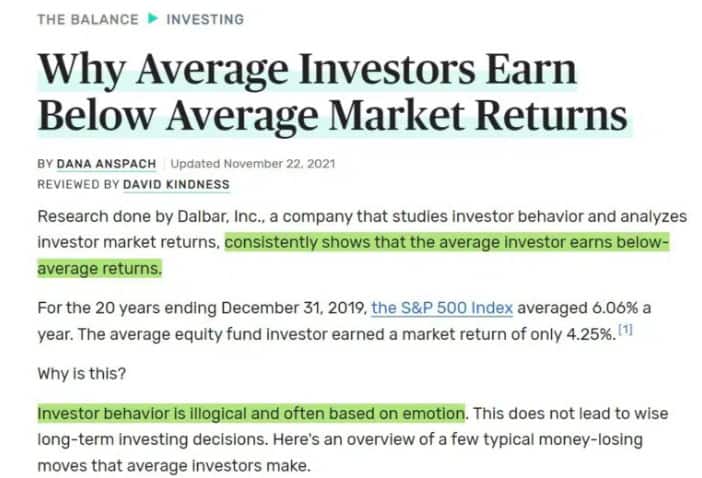 Average Investors Earn Below Average Returns Image via the balance
Average Investors Earn Below Average Returns Image via the balanceThere is a very simple investment concept, “buy low and sell high.” That sounds straightforward, doesn’t it? There is literally only one thing you need to do to make money in the markets, so why do most people underperform or lose money? It all comes down to fear and greed. As our investments start to go up, greed kicks in and we don’t want to sell as we hold on thinking, “what if it goes higher?”.
Anyone who sold Bitcoin at 20k is probably kicking themselves as they watched it shoot up to 60k, but ultimately, it is greed that makes us hold onto assets for too long, and instead of selling for a profit, most investors get too greedy to cash out and end up holding assets as their prices plummet back down to Earth. Taking profits too early can be painful, but anyone who has experienced selling too early will probably agree that it is better to sell too early than to hold too long and see their investment go to zero or even negative. People have never gone bankrupt taking profits, as the saying goes.
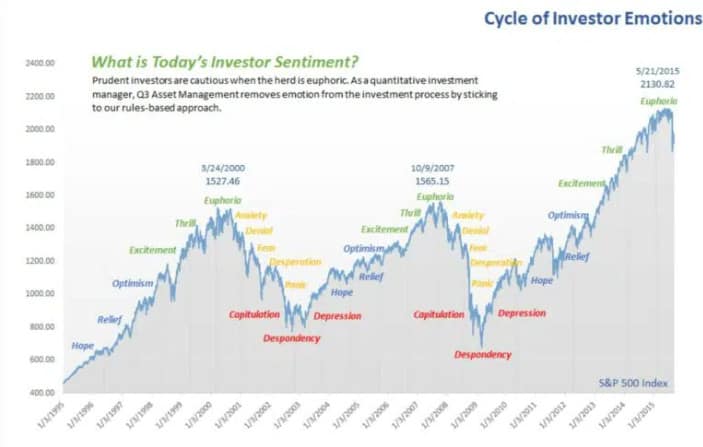 An Image Showing the Investor Sentiment Lifestyle. Watch Out for Euphoria, This is Where Investors Get Burned by Greed Image via q3tactical.com
An Image Showing the Investor Sentiment Lifestyle. Watch Out for Euphoria, This is Where Investors Get Burned by Greed Image via q3tactical.comA majority of investors get wrecked when they buy into and hold beyond the Euphoria stage of investing as their investment has been going well, they feel like geniuses as they are wealthy! (on paper) and they are so confident that their investment is going to boom that they continue to hold and may even start putting more money in here. They are no longer buying low nor selling high, are they? They were too greedy to sell at a time when the downturn is around the corner, as it is with every market. Even when markets dip at the first sign, greed causes many investors to hold on hoping for a temporary dip. Instead of selling when markets dip 10%, investors will hold as prices continue their downward spiral. Check out this chart.
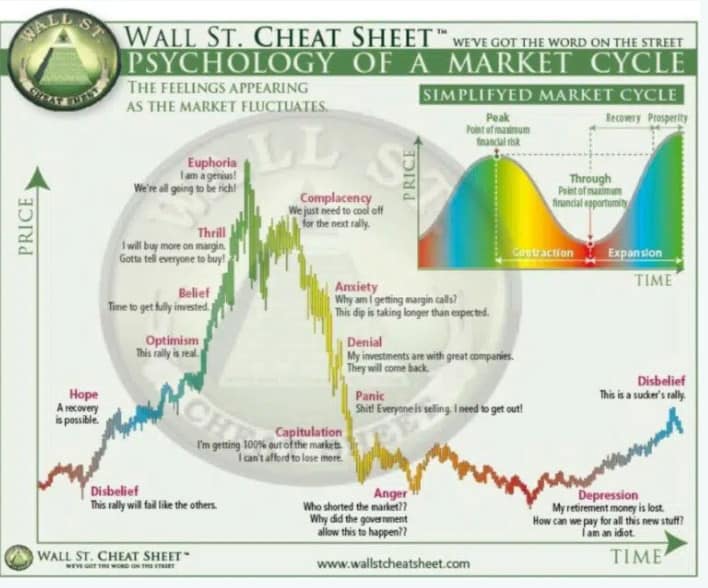 Popular Graphic Highlighting Investor mentality image via steemit.com
Popular Graphic Highlighting Investor mentality image via steemit.comTwo forms of fear are part of the ugly two-faced emotion monster that wrecks investors. The first scenario where investors allow fear to hurt their portfolio is that many will sell early when a dip in the market occurs, regardless of whether the market is in an overall uptrend, not allowing the full market cycle or trend to unfold. In a very crude and simple example, if a market went up 5% drops 2% up 5% drops 2% up 5%, many investors would have panic sold at the first 2% drop and sold, missing out on the subsequent 10% rally. The next way that fear can be a terrible beast is that many investors will panic sell at a loss if the price falls below their entry position, and they will end up with a net loss.
“Be fearful when others are greedy, and be greedy when others are fearful,”
-Warren Buffet wrote in a 1986 Berkshire Hathaway Shareholder letter.
The darker quote that highlights the similar message of buying low and selling high when market conditions are unfavorable comes from Baron Rothschild, an 18th-century British nobleman and member of the Rothschild banking family, one of the richest families in history who made a fortune during panicky and crashed markets. That also followed the Battle of Waterloo:
“The time to buy is when there is blood in the streets,”
-Baron Rothschild following the Battle of Waterloo
In today’s society, this quote isn’t meant to be taken as literally as it is used to describe the time to buy is when the markets are down (blood red) in the streets (Wall Street). Contrarian investing is often called being against human nature and instinct, and it is very difficult to do.
People are afraid and want to sell as markets crash, but that’s the best time to buy, so it’s like trying to catch a falling knife. It is easy to sell when you think you may make a bucket load of cash if you hold on a bit longer when the markets are booming and everyone is piling in thinking an asset is heading to the moon, but it is hard to sell when you think you may make a bucket load of cash if you just hold on a bit longer. Is the market in euphoric greed or panic fear? Fear and greed indexes can help answer that question.
Introducing the Fear and Greed Index #
For different markets, fear and greed indexes are different. CNNMoney created The Fear and Greed Index for the stock market to measure two of the primary emotions that influence how much investors are willing to pay for stocks. An index is calculated every day, week, month, and year. To measure fear and greed in the market, the index examines seven different factors to establish whether the stock market is fairly priced. A scale from 0 to 100 is used to measure the seven factors: market momentum, market strength, trading volume, put and call options, junk bond demand, market volatility, and safe-haven demand. Here’s how they are measured in full.
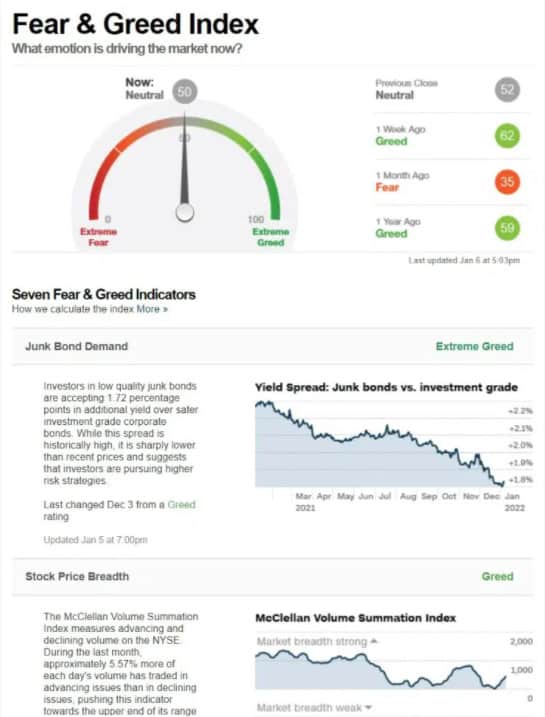 CNN’s Market Fear and Greed Index Image via money.cnn
CNN’s Market Fear and Greed Index Image via money.cnnIn fact, it became so popular and useful that the same concept was applied to other markets, such as the beloved crypto market. The Crypto Fear and Greed index is published by the website Alternative.me, and it measures the emotions and sentiment driving the cryptocurrency markets. In the website’s opinion, the index was created to prevent people from overreacting emotionally to FOMO as markets are rising and people sell irrationally when they see red numbers. To visualize progress in sentiment change, the Crypto Fear and Greed Index analyses data from five bitcoin-related sources, valuing each data point at the same level as the day before. In the current version of the index, Bitcoin and other large cryptocurrencies are included, but the team plans to develop separate indices for alternative cryptocurrencies soon.
The different factors measured in the Crypto Fear and Greed index are as follows:
- Volatility (25%)- The index measures the current volatility and max drawdowns of Bitcoin and compares it to the corresponding average values of the last 30 and 90 days.
- Market momentum/Volume (25%)- The index measures the current volume and market momentum and compares it with the last 30/90-day average values and puts those two values together.
- Social Media (15%)- The index is able to analyze market-related keywords across Reddit and Twitter to check how fast and how many interactions are related to Bitcoin. The team notes that this feature is still experimental, and they are optimizing how the function works.
- Surveys (15%)- Using strawpoll.com, which is a large public polling platform, there are weekly crypto polls asking people how they see and feel about the market. This metric is currently paused as the team doesn’t feel it is worth giving those results too much attention.
- Dominance (10%)- The dominance of a coin resembles the market cap share of the entire crypto market. A rise in Bitcoin dominance is often caused by fear as it is the “safe-haven,” for crypto investors, and when Bitcoin dominance shrinks people are more confident and therefore greedy and willing to speculate in smaller altcoins as investors are looking for the potential of higher gains as many altcoins can out-perform Bitcoin in the short term.
- Trends (10%)- The index pulls data from Google Trends for various Bitcoin-related search queries, focusing more on the changing of search volumes as well as other popular Bitcoin-related searches.
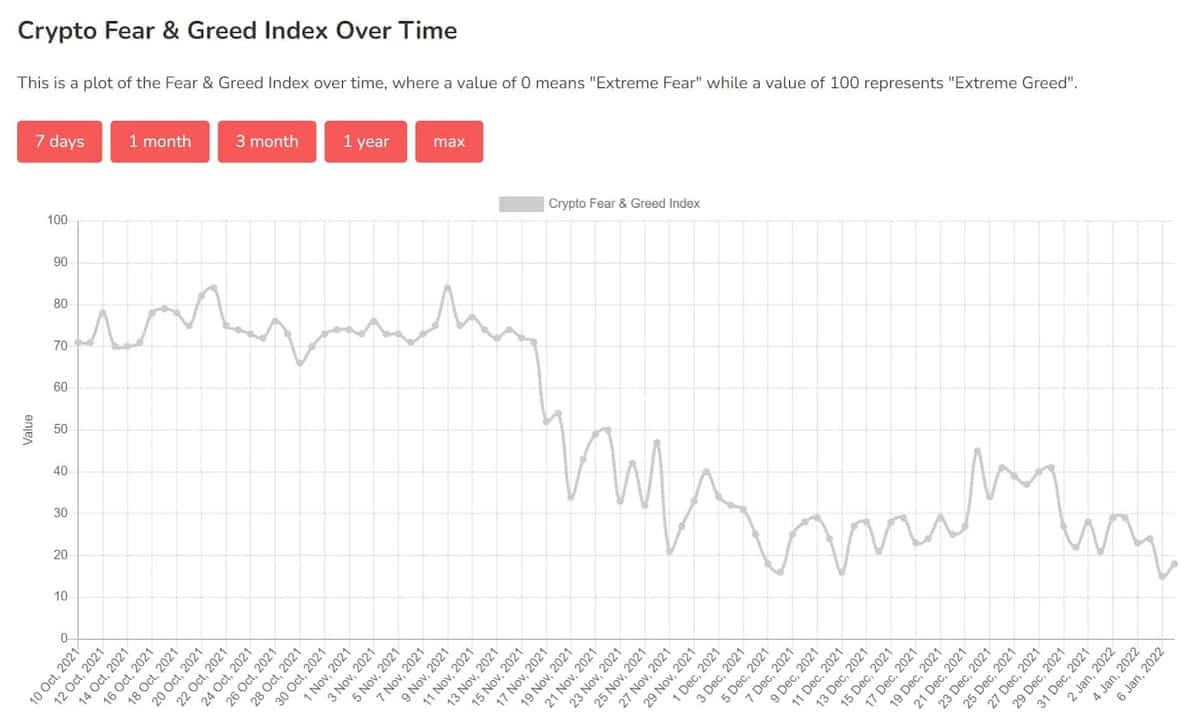 The Crypto Greed and Fear Index can be Analyzed Over Time Image via alternative.me
The Crypto Greed and Fear Index can be Analyzed Over Time Image via alternative.meWith all that data, the index crunches the numbers into a simple meter from 0 to 100, with zero being extreme fear while 100 means extreme greed.
Conclusión #
Fear and Greed Index offers great insight into the general market sentiment, however it shouldn’t be taken as gospel and solely relied upon for investment decisions. In conjunction with other fantastic metrics like those found on the website lookintobitcoin.com, this is one of the many important metrics to keep an eye on. For those of us immersed so deeply in crypto that we forget to look beyond our bubble, The Fear and Greed Index is a great tool.
Almost everyone I socialize with is into crypto, and we can sometimes get caught up in our own echo chambers when surrounded by other crypto enthusiasts.
Sometimes it is hard to remember that we are still early and most people are not here yet. I may feel euphoric after attending a crypto conference, and my friends may chat about Bitcoin and think we are nearing a top, but the Fear and Greed Index may indicate people are still fearful, and our euphoria may be temporary. Be completely misplaced so it can act as a great “reality check.”
References:
Fear & Greed Index – Investor Sentiment. (2021, January 12). CNNMoney. https://money.cnn.com/data/fear-and-greed/
Crypto fear and greed index. (2021, June 10). Https://Coingecko.Live. https://coingecko.live/en/fear-and-greed-index
Are You Making These Money-Losing Investment Moves? (2021, November 23). The Balance. https://www.thebalance.com/why-average-investors-earn-below-average-market-returns-2388519